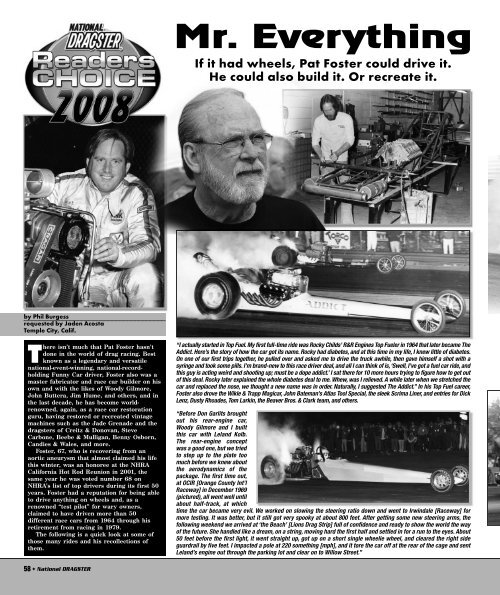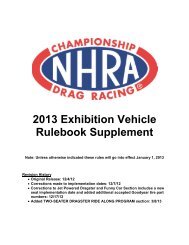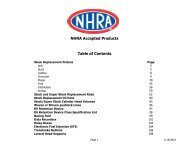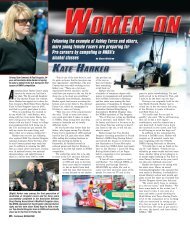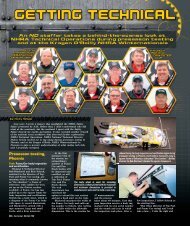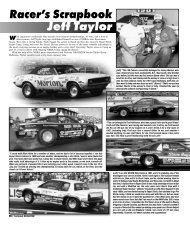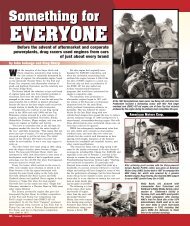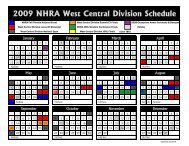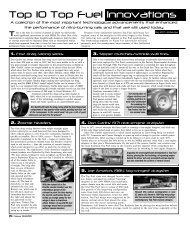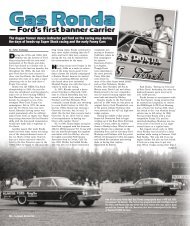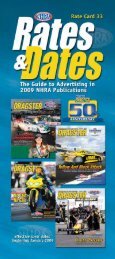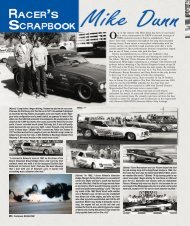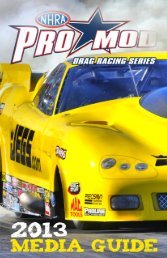Mr. Everything - NHRA.com
Mr. Everything - NHRA.com
Mr. Everything - NHRA.com
- No tags were found...
Create successful ePaper yourself
Turn your PDF publications into a flip-book with our unique Google optimized e-Paper software.
<strong>Mr</strong>. <strong>Everything</strong><br />
If it had wheels, Pat Foster could drive it.<br />
He could also build it. Or recreate it.<br />
by Phil Burgess<br />
requested by Jaden Acosta<br />
Temple City, Calif.<br />
There isn’t much that Pat Foster hasn’t<br />
done in the world of drag racing. Best<br />
known as a legendary and versatile<br />
national-event-winning, national-recordholding<br />
Funny Car driver, Foster also was a<br />
master fabricator and race car builder on his<br />
own and with the likes of Woody Gilmore,<br />
John Buttera, Jim Hume, and others, and in<br />
the last decade, he has be<strong>com</strong>e worldrenowned,<br />
again, as a race car restoration<br />
guru, having restored or recreated vintage<br />
machines such as the Jade Grenade and the<br />
dragsters of Creitz & Donovan, Steve<br />
Carbone, Beebe & Mulligan, Benny Osborn,<br />
Candies & Wales, and more.<br />
Foster, 67, who is recovering from an<br />
aortic aneurysm that almost claimed his life<br />
this winter, was an honoree at the <strong>NHRA</strong><br />
California Hot Rod Reunion in 2001, the<br />
same year he was voted number 68 on<br />
<strong>NHRA</strong>’s list of top drivers during its first 50<br />
years. Foster had a reputation for being able<br />
to drive anything on wheels and, as a<br />
renowned “test pilot” for wary owners,<br />
claimed to have driven more than 50<br />
different race cars from 1964 through his<br />
retirement from racing in 1979.<br />
The following is a quick look at some of<br />
those many rides and his recollections of<br />
them.<br />
“I actually started in Top Fuel. My first full-time ride was Rocky Childs’ R&R Engines Top Fueler in 1964 that later became The<br />
Addict. Here’s the story of how the car got its name. Rocky had diabetes, and at this time in my life, I knew little of diabetes.<br />
On one of our first trips together, he pulled over and asked me to drive the truck awhile, then gave himself a shot with a<br />
syringe and took some pills. I’m brand-new to this race driver deal, and all I can think of is, ‘Swell, I’ve got a fuel car ride, and<br />
this guy is acting weird and shooting up; must be a dope addict.’ I sat there for 10 more hours trying to figure how to get out<br />
of this deal. Rocky later explained the whole diabetes deal to me. Whew, was I relieved. A while later when we stretched the<br />
car and replaced the nose, we thought a new name was in order. Naturally, I suggested The Addict.” In his Top Fuel career,<br />
Foster also drove the Wikle & Trapp Magicar, John Bateman’s Atlas Tool Special, the sleek Scrima Liner, and entries for Dick<br />
Lenz, Dusty Rhoades, Tom Larkin, the Beaver Bros. & Clark team, and others.<br />
“Before Don Garlits brought<br />
out his rear-engine car,<br />
Woody Gilmore and I built<br />
this car with Leland Kolb.<br />
The rear-engine concept<br />
was a good one, but we tried<br />
to step up to the plate too<br />
much before we knew about<br />
the aerodynamics of the<br />
package. The first time out,<br />
at OCIR [Orange County Int’l<br />
Raceway] in December 1969<br />
(pictured), all went well until<br />
about half-track, at which<br />
time the car became very evil. We worked on slowing the steering ratio down and went to Irwindale [Raceway] for<br />
more testing. It was better, but it still got very spooky at about 800 feet. After getting some new steering arms, the<br />
following weekend we arrived at ‘the Beach’ [Lions Drag Strip] full of confidence and ready to show the world the way<br />
of the future. She handled like a dream, on a string, moving hard the first half and settled in for a run to the eyes. About<br />
50 feet before the first light, it went straight up, got up on a short single wheelie wheel, and cleared the right side<br />
guardrail by five feet. I impacted a pole at 220 something [mph], and it tore the car off at the rear of the cage and sent<br />
Leland’s engine out through the parking lot and clear on to Willow Street.”<br />
58 ✦ National DRAGSTER
“Don Kirby’s Beach City Corvette had a bad reputation for crashing and burning<br />
— Gary Gabelich drove it off the end of Orange County and out onto the freeway<br />
— but I never crashed it or burned it. I made some awesome runs in it but<br />
stopped driving it after I crashed our rear-engine car at Lions.”<br />
“The Mustangs that I built for Mickey Thompson in 1969 were pretty revolutionary for the time.<br />
We took a lot of ideas from the Top Fuelers, with a narrow chassis and a dragster-style roll cage,<br />
and put [zoomie] headers on it. I built two, one that I drove and one that Danny Ongais drove. It<br />
was the first Funny Car to run 200 mph and would e.t. pretty well.”<br />
(Above) “I drove ‘the Greek’s’ [Chris Karamesines]<br />
Fuller-built Mustang Funny Car and even his Top<br />
Fueler on occasion in 1969. He didn’t like driving<br />
the Funny Car, but he had one because everyone<br />
else had one. Cliff Zink, Ron O’Donnell, Norm<br />
Weekly, and I drove this car. It was basically a<br />
spare-weekend car for him, but it meant the world<br />
to drive for him. You’re a kid stumblin’ around the<br />
Midwest, driving race cars whenever you can,<br />
most likely starvin’ on occasion, but just gotta live<br />
your dream. Then, when you’re about to chuck it<br />
all and get a real job, the fabled ‘Golden Greek’<br />
says to you, ‘Hey, kid, ya wanna drive my Funny<br />
Car on tour’ Are you kiddin’ me”<br />
“In 1970, I drove for John Bateman in the Atlas Oil Tool Special Maverick but ended up losing<br />
that ride. We were at Capitol Raceway in Maryland, towing back down the return road after a<br />
pass. I was in the race car with the body up. I caught the eye of some dolly in the stands next<br />
to the return road. I smiled, waved, and tried to signal her to meet me in the pits. For whatever<br />
reason, the truck stopped, but the hero racer didn’t. I hit the back of the truck at about 25-30<br />
mph. We drove to Chicago, and Bateman dropped me off at [Chris Karamesines’] shop to get<br />
the car fixed, but when he came back, he had a new driver with him.”<br />
(Left) “After Bateman, I drove for<br />
Roland Leong in the Hawaiian for<br />
three or four months in late 1970<br />
with this Dodge Charger. We got<br />
along well, but it seems like he<br />
always had a new plan in mind<br />
and the next new driver ready to<br />
go. We ran Indy and did well, and<br />
we parted with no animosity.”<br />
(Below) “I also got to drive ‘Big<br />
John’ Mazmanian’s Barracuda in<br />
1970, testing the car for the kid,<br />
Rich Siroonian. His mom was<br />
touchy about him driving a car<br />
until it had been tested. I did that<br />
kind of thing a lot. I had some<br />
natural driving talent, but I was<br />
also a car builder, so I could relate<br />
to what the car was doing”<br />
“I drove Don Cook’s Damn Yankee Barracuda for most of 1971. This was a Woody<br />
car. I drove it up through Indy before I went to work with Barry Setzer. Ron O’Donnell<br />
took over for me with Cook.”<br />
to page 60<br />
March 21, 2008 ✦ 59
from page 59<br />
“Barry Setzer’s Vega, obviously, was the best car I ever drove. It was a consistent money winner. I drove it from late 1971<br />
through 1973, and we won a lot. We won the Manufacturers Meet at OCIR in 1971 and ran 6.29 in 1972, which was the<br />
quickest pass of the year. The next year we went to three straight final rounds, winning the Gatornationals and were<br />
runner-up at the Springnationals and Summernationals. Barry was a manufacturer of high-end fabric from Hickory,<br />
N.C. He contracted Ed Pink in 1970 to build motors for a Pro Stock Camaro he owned, and Ed exposed him to Funny Cars<br />
and loved them. He then had Pink put together a turnkey Funny Car operation. Kelly Brown was hired to drive.<br />
I was in Cook’s car at the time. With an over-the-counter Pink engine, we consistently ran quicker than the<br />
Setzer car with little or no budget. This caught Pink’s attention. He asked me to help him with the Setzer car<br />
at a test session at OCIR. My answer to Ed was, ‘No deal. Put me in the car on a permanent basis, and we’ll<br />
talk.’ He did that, and from then ‘til Barry quit drag racing in 1973, we did well. We went after it seriously on<br />
every run, like every run was for the national championship. We got chided by some of the smaller teams for<br />
running that way, but I told them I had a car owner who wanted to tip the world over every time we went to<br />
the starting line and that was my job. Barry was a quiet, soft-spoken, intelligent man, a man of his word, and<br />
always a gentleman. A better car owner would be hard to find.”<br />
“I drove a couple of cars for<br />
just a few races, like Larry<br />
Huff’s Soapy Sales Demon and<br />
this car, the Keeling & Clayton<br />
California Charger. I only drove<br />
this car for a couple of<br />
weekends, and [John Keeling<br />
and Jerry Clayton] were good<br />
to drive for, but they didn’t run<br />
as often as I would have liked<br />
to and didn’t quite have the<br />
match race spirit.”<br />
“Driving for ‘Lil John’ Lombardo in 1974 was one of my most pleasant<br />
experiences. John was such an easy guy to get along with and was very<br />
smart. He ran the car the way I would run a car, and we just excelled. That<br />
Vega was a contender wherever it went. I even toured the car for him by<br />
myself when his business, which was terrazzo flooring, got too busy. We<br />
won the 1974 OCIR Manufacturers Meet with this car.”<br />
Foster drove the popular Chicago Patrol Funny Car during the 1975 season. Owned by Chapman<br />
Automotive from Chicago and serving as a promotional tool for the Chicago Police Department —<br />
<strong>com</strong>plete with flashing blue lights on the roof — it was a match race staple during the 1970s and<br />
later was turned into a rocket Funny Car. “That was a soldier car; it didn’t have a lot going for it,<br />
but we could always seem to get it together to make it run. Alan Gillis was an excellent mechanic.<br />
We actually took this car back from a late-model [Hemi] to a Donovan and ran really well with it.<br />
It was very popular and had the lights on the top — when Pat would remember to turn them on.”<br />
“Gerry Glenn drove this car for a while, but Jimmy [Glenn] and I were good<br />
friends and asked me to drive it in 1976 and 1977. We ran pretty good with<br />
this car, down into the 6.20s as I recall. This car was an example of what<br />
kept me driving so many cars; I could get in a car that was a little bit off<br />
pace and, through some technical abilities, be able to pull a few strings and<br />
get it to the front of the field.”<br />
“I drove for Joe<br />
Pisano for a<br />
couple of years,<br />
1977 and 1978.<br />
We got along<br />
really well, even<br />
though his car<br />
wasn’t running<br />
all that well<br />
during that<br />
period, which is<br />
why we stopped<br />
racing together.<br />
Joe was all about making horsepower, and he was trying to use too much of it and<br />
made the car into a real shaker. He thought I should be able to cure it with the<br />
clutch; I thought he should take a little fuel out of it.”<br />
“I left Pisano to drive<br />
for Harry Eberlin,<br />
who owned the<br />
Super Shops chain.<br />
Ed Pink put that deal<br />
together, and he<br />
wanted me to go<br />
help them tune it for<br />
Dave Hough, who<br />
was driving at the<br />
time. Well, you know<br />
me, I couldn’t do that, and I eventually got to drive it full time in mid-1978. That car hauled ass. We<br />
got in the Cragar Five-Second Club as the third car to run in the fives [5.99 at Fremont Raceway, April<br />
8, 1979]. Bernie Lewis was the tuner and did a great job. It was tough little hombre. This was the last<br />
nitro car that I drove. I was getting to an age where I wasn’t at the top of everyone’s option list<br />
anymore because I didn’t have the TV smile, and I didn’t want to be in a personality race.”<br />
60 ✦ National DRAGSTER


